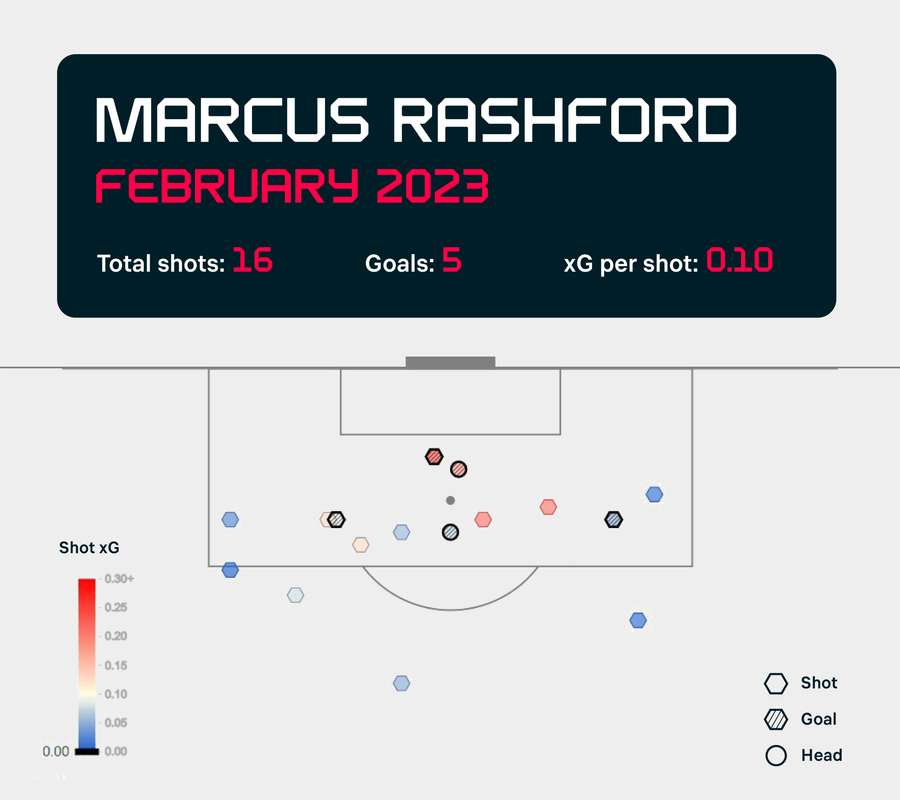Marcus Rashford leads the way after magical month for star player

Since the Premier League resumed after the World Cup, Rashford has scored in every game but one, adding 10 goals to his tally in that time.
In February, he added five league goals and scored in the League Cup final. Also, his goal also helped his side advance past Barcelona in the opening round of the Europa League knockout stages. Of the midfield players at Old Trafford, coach Erik ten Hag has only entrusted Bruno Fernandes with more minutes during his time at Manchester United.
This successful season is in stark contrast to the previous one. Rashford missed the opening seven games due to shoulder surgery and in the remaining ones he was trusted in the starting line-up only 13 times. In the end, he spent 1,343 minutes on the pitch and scored just four goals.
In terms of data, the low minutes were probably justified. Rashford only averaged 1.47 shots per game, meaning he only had 22 shots on goal throughout the entire season. Of those, only six of them were from the central area inside the opposition's penalty area - the danger zone - where the chances of scoring are mathematically highest.
The rest of his shots came either from a tight angle or from outside the box, and according to the pattern of expected goals, he should have scored only three times.
In the advanced data model, which evaluates a player's contribution in the final third of the field based on how his movement and passing increases his team's chances of scoring, he scored below average - 60% of other wingers did better on this metric.

But all that is already forgotten as Rashford is producing elite numbers in the current campaign. While last season his movement in the penalty area was not ideal and it was very difficult for him to finish, now only his national teammate James Maddison is more active between the wings, and he is also very often in the middle of the pitch and often shoots from outside the area.
Compared to last season, Rashford is shooting from significantly better positions - only Mohamed Salah, Raheem Sterling and Son Heung-Min are currently getting more dangerous chances. But while the aforementioned trio are finishing below their capabilities, Rashford is handling his chances excellently.
Son has converted only 8% of his shots so far, Salah 12% and Sterling 15%. Rashford, however, is at 21%, which is a huge success rate considering his shooting activity. Only Phil Foden, Kaoru Mitoma and Yoane Wissa have done better in the Premier League, only while Rashford shoots on target three times a game, in their case we are talking about an average of 1.5 to 1.8 shots.
In February's Premier League games, Rashford racked up 16 shots on goal, just six fewer than he had in all of last season combined, and he needed just 1.53 xG (0.38 per 90 minutes) to make those five clinical shots.

Such a large disparity is also due to a certain amount of luck and in the long run a similar flow of goals is unsustainable, but in Rashford's case it also means an improved finishing technique.
In fact, we also have historical data containing a sample of 16,539 minutes played (from the 15/16 season to the current one). And it says that out of his 449 shots, he collected 57 expected goals and 73 real ones.
That means the average Premier League player would have scored 16 fewer goals from the same shots. So it's safe to say that finishing has long been one of Rashford's strengths.
And because he now regularly gets into a large number of dangerous positions and has significantly reduced his shooting from distance, this ability is even more evident. For example, he averaged two shots per game from the danger zone in February's games, a result normally achieved by the best nines in the world. Harry Kane, Gabriel Jesus and Ivan Toney are all at the same level in the Premier League.

